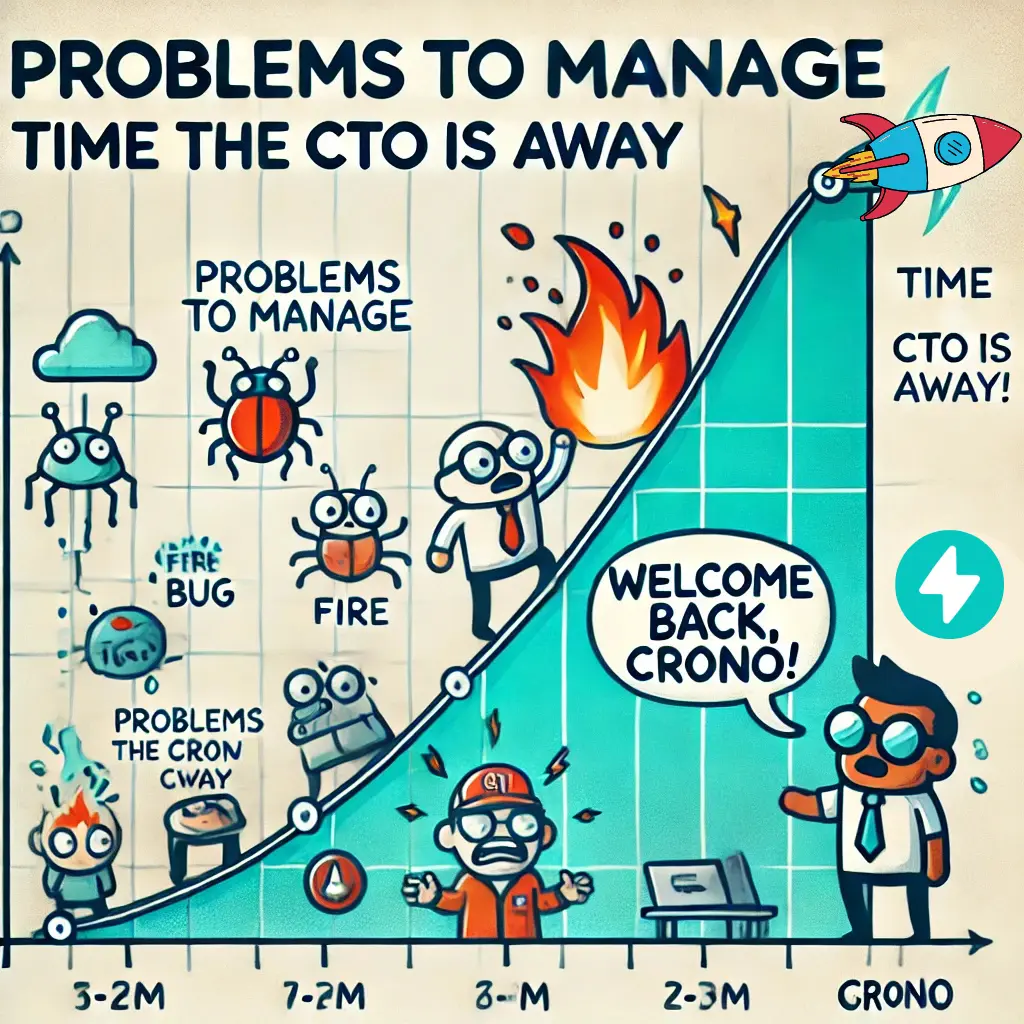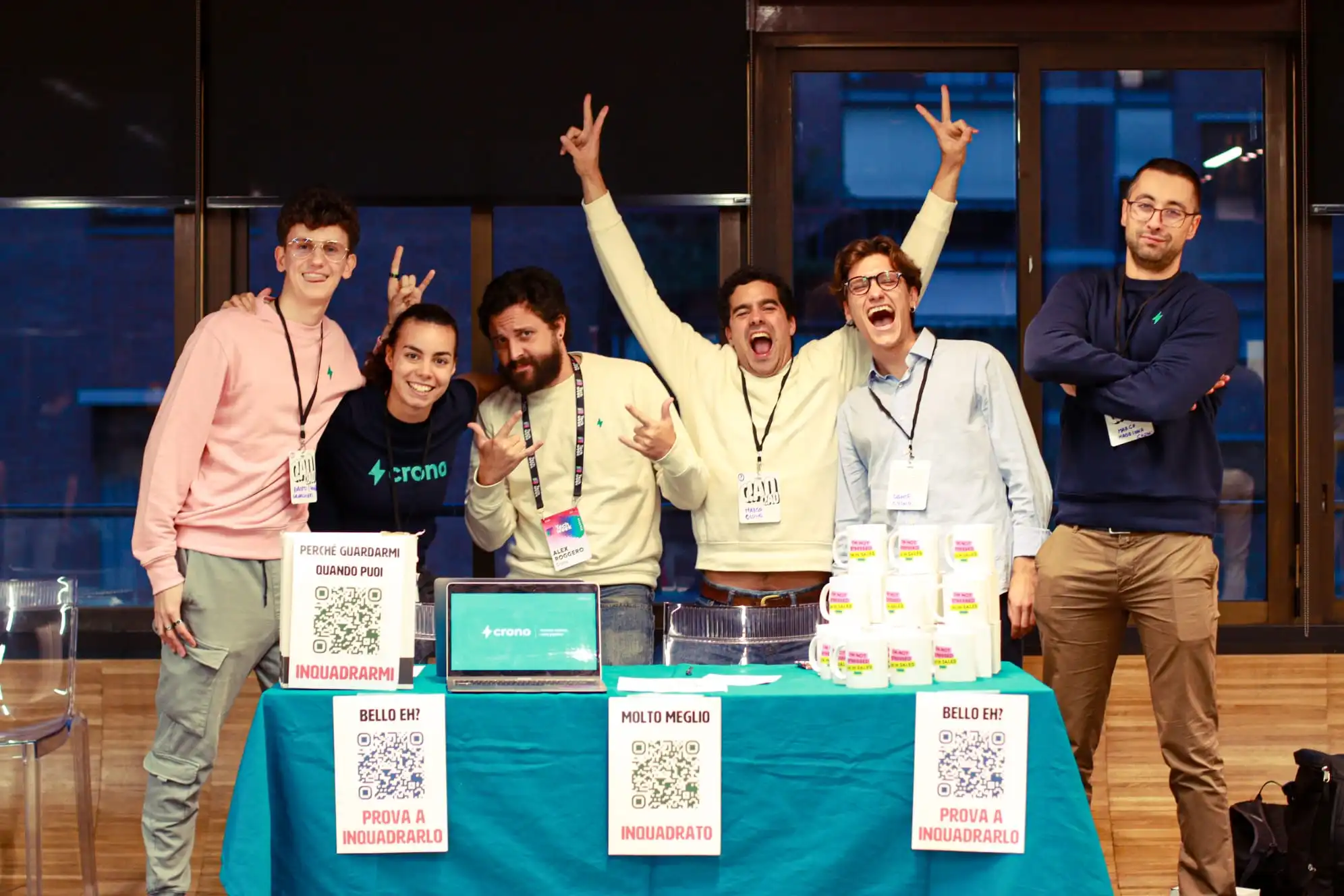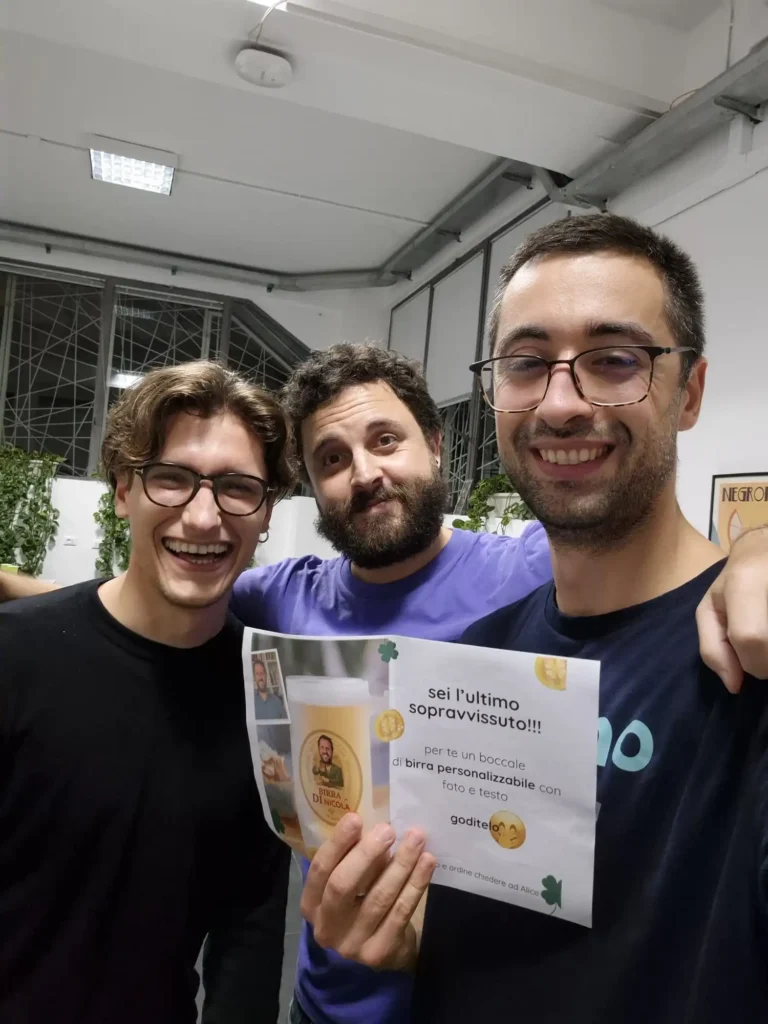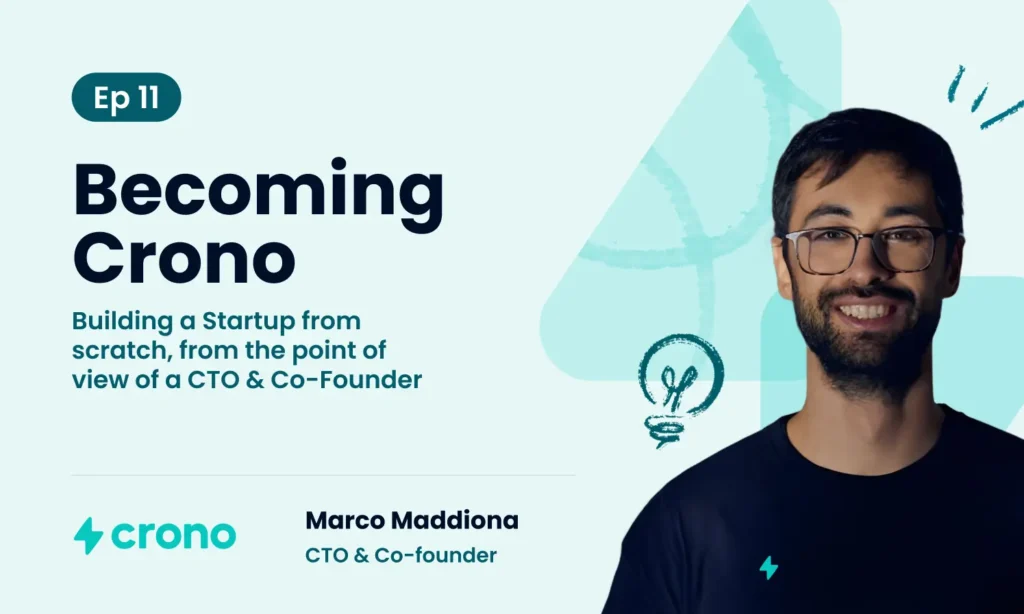Building a startup from an idea can be an exciting adventure that tests resilience, passion, and commitment. It’s about creating something entirely new and adopting the right mindset to turn it into a successful reality.
With “Becoming Crono” we’ll revisit our starting point through an honest and captivating memoir written by our CTO, Marco Maddiona.
Each month, you’ll have the opportunity to witness firsthand the steps that propelled Crono into a startup with +150 customers all over the world. This will encompass the obstacles we overcame and the choices we made. Have you ever wondered what it’s like to develop software while building a business?
Enjoy our new episode of Becoming Crono!
Ep. 11 - Scaling business and life
Hi Croners, I’m Marco Maddiona, CTO & Co-Founder of Crono, welcome back! In case you have missed the previous episodes head here to read the very start of our adventure. Now, let’s dive right into our story!
In the last episode, we left off after a Summer of Growth. Let’s go on: it’s September 2024.
Coming back from a week of vacation, especially from a wonderful place like Puglia, is never easy.
Especially if you’re the CTO of a startup.
I’ve come up with a law, still unnamed (suggestions are welcome): the amount of things to handle and their ability to pile up during the CTO’s absence grows exponentially and tends to +∞.

Although the team did a great job handling any issues that arose, I still manage several technical issues directly. Maybe a quick digression is needed to provide context and avoid the impression of disorganisation.
Developing fast and tech debt
Many of the processes or modules I still handle could actually be managed by the rest of the team, but the fast-paced nature of a startup and a product that aims to grow quickly doesn’t always leave time to transfer all the knowledge, especially about the more consolidated parts of the software.
Moreover, we try to invest most of our resources into developing innovations and new features — in other words, everything that helps us “sell more.”
The decision we made was to allocate resources toward developing new modules and features, and continue transferring knowledge when necessary, as existing modules get touched by the development of new ones, which also supports refactoring efforts.
Given this decision, if a problem arises or if a modification is needed on existing modules, I often have to step in personally. As we grow as a team, shared knowledge increases and the software becomes more cohesive.
And so September begins, and it’s back to focus, into the vortex. The roadmap to year-end is ambitious, and we dive back in to keep improving the product and driving sales.
Oh, I also needed to update you on the client I mentioned in the previous chapter.
Our bet paid off.
The custom development we delivered allowed their employees to try out the platform, and they were impressed and excited. Since then, their user count keeps rising (28 at the time of writing)!
This was a huge win for us because the company in question is Alibaba (Europe). Having big names in a startup’s portfolio is a major credibility boost and helps us gain leverage with other companies.
When bets like these pay off on a startup journey, it’s incredibly rewarding. But it’s important to remember that these results are the outcome of all the previous work, not because we randomly pulled a joker from the deck.
Sure, sometimes pulling a joker can help (both for business and morale), but keeping this in mind makes it easier to understand that even when things go wrong, you’re still going through a growth phase. It’s the sum of continuous small efforts that brings results.
The Italian Tech Week
As September draws to a close, we manage to gather part of our Italian team in Turin for Italian Tech Week. It was our first time attending with so many team members, and it was valuable for several reasons:
- So many inspiring talks and interesting people we met helped grow our awareness and understanding of the tech and startup world.
- It’s great to see your team “moving” within a major event. From someone trying to sell Crono in the food truck line, to pitching to investors while waiting to hear Sam Altman speak, to fixing a bug over the phone while standing up, and the desperate hunt for power outlets and Wi-Fi—it’s clear we can’t sit still even at an event. That means we’re all focused on the same goal.

“Oh, you’re the folks from Crono—I know you!”
Hearing this more and more often (especially from people we’ve never met) shows that we’re doing a great job (huge kudos to the Marketing team led by Sof and Alex). Once we were back from our Turin adventure, we got our heads back down and kept developing.
Our focus for the end of the year has been continuously improving our users’ workflows—boosting automations across different stages, delivering more useful data for decision-making, and backing everything with AI.
The AI Bet
Nowadays, it’s easy to say AI has changed how we work, but not all the software we use daily has truly transformed the user experience (have you tried writing a formula in Excel recently? What’s really changed in 25 years?).
Finding the right way to implement AI isn’t simple, and even though we introduced generative AI in Crono from day one, it still took us time to figure out the most effective way to bring it to our users.
Product development is iterative, and it’s essential to learn from users what to build and how.
After several tests, research, and user interviews, we identified a few core features that allowed us to take Crono to the next level with AI:
- Sequence generation optimized for each target
- Personalization of each message flow using contextual info from the prospect
- Data enrichment and classification to provide deeper insights
It sounds like a lot of work in a short amount of time for such a small team (five developers, including me), but AI not only helps improve the product, it helps build it.
Beers, wins and scaling a backend
That said, startups aren’t all serious business: in October, we took part in one of the top sports events organised by our coworking space (WAO)—the prestigious Beer Pong tournament.
I have to confess: I hate Beer Pong.
I hate when the ball bounces off the plastic cup and flies out, or circles the rim three times before falling out. It seriously drives me nuts.
That’s why I usually avoid playing.
But that night was different: we were playing for Crono.
The team (me, Dante, and Alex) was super in sync, and we really brought our A-game. That night, I had the same confidence Michael Jordan had when he made a free throw with his eyes closed.
And we won. Against seasoned teams that had trained for this for years. It was one of Crono’s proudest moments (up to that point, anyway).

After that moment of joy, we didn’t waste any time and kept pushing the accelerator. September and October turned out to be excellent months in terms of sales. The ongoing improvements to the product were drawing the attention of new customers and increasing the satisfaction of existing ones.
When the number of users grows, there are always technical aspects to consider: the backend must scale.
A (good) CTO needs to be aware of the capacity and limits of their infrastructure but what do you do when resources are limited and you’re heavily investing in features and user experience?
In short, we tried to push Crono to its limits, fully aware we couldn’t keep doing it for long given our growth pace.
Scalability issues were starting to become noticeable even to users, so we knew we had to do something in the short term, even though we didn’t have enough internal skills and resources to properly optimize our cloud architecture.
Let me put it differently: with more time and patience, we could’ve studied the best solution and implemented it ourselves. But when you’re working in such a fast-paced environment, you often don’t have the time you want, let alone the patience. So this remained an unresolved issue for us.
Time flies when you’re focused on something, and before you know it, it’s mid-November: Web Summit time in Lisbon.
Like every year, we couldn’t miss it but unlike previous editions, we decided, for various reasons, to make a smaller trip. Fewer days and fewer people, especially since Lorenzo was in the middle of a move.
Websummit, two years later
Following the (unnamed) law I mentioned at the beginning of this article, going to Lisbon wasn’t exactly a walk in the park for me.
Partly because I decided to deploy some delicate changes to production just before leaving (lesson learned), and partly because of the architecture issues I mentioned earlier, I ended up spending most of the event trying to support the team in solving problems.
Sure, I could’ve avoided the release. But when you have a roadmap to follow, you accept the risk of breaking something in exchange for the advantage of releasing new features quickly and gathering user feedback to iterate and continue development.
In short, given the context, sometimes you have to take a bit of a risk.
Anyway, the Web Summit turned out, as always, to be an amazing event.
For me, being there and discovering as many startups as possible helps me spot tech trends and find potential new services or partners that could improve our product.
And that’s exactly what happened. Luckily, I met an Italian startup that spun out of a software company specialized in AWS: Polarity.dev. It was a totally random encounter after a morning spent trying to manage and solve our infrastructure problems.

When there’s a technical problem, my computer engineering instincts push me to find a solution myself. But when you don’t have enough time or resources, I’ve learned that asking for help from an external partner, specialized in that exact field, is far less expensive.
So after that chat, we decided to reconnect right after the event and, thanks to the deep expertise of their founder, Valerio Versace and his team, we quickly found a way to fix the most urgent issues and planned a series of infrastructure improvements over the following months.
These allowed us to optimize our cloud architecture and make it more robust, secure, and scalable (and gave the CTO some peace of mind).
The Web Summit flew by, of course, not without side parties and big dinners in Lisbon’s lively nightlife. “When Crono’s around, there’s always a party,” quote.
Once the scalability issues were resolved and we started releasing the new AI features, the product began to reach a new level of maturity. This was also reflected in the numbers: users kept growing, and so did licenses sold.
We were heading into the end of the year riding this positive trend (with +15% month-over-month growth). When the numbers grow, so does the awareness of your value—and the team’s morale.
We knew we were crushing it, but we also knew that in this industry, you always have to do more to stand out from the competition, which means never stopping to study how to improve and innovate the product.
Around that time, I was also hit with personal news: my partner found out she’s pregnant, we’re going to be parents in June 2025. It was an immense joy for me.
Maybe someday I’ll share more about how I felt in an article, for now, I’ll just say that Having Kids by Paul Graham helped me a lot.
I’m sure this will have an impact on my life and my work:
now I have one more reason to keep going.
